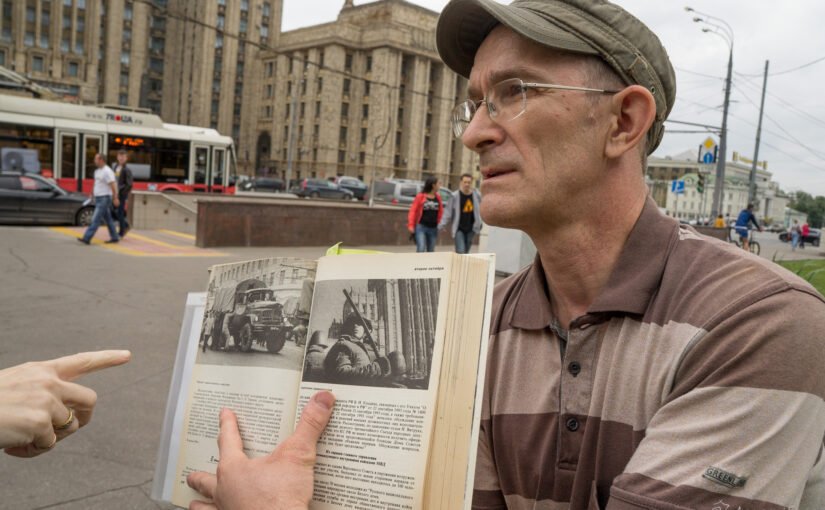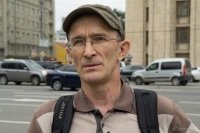With this person I found myself connected by a multitude of bizarrely twisting threads of fate and acquaintances. On October 3, 1993, a crowd of demonstrators, breaking through police cordons on the move, rolled to liberate the White House from the blockade with parliamentarians and opposition of all stripes inside. After another clash with the police on Smolenskaya, I filmed it for the first time – lying lifeless on the asphalt, covered with a red flag (as it turned out later, the one with which he went to the demonstration). I was told that an army truck ran over him. Having clicked the camera, I rushed to look for help – it was painfully bad. As it turned out recently, someone at that moment took a picture from the opposite side – so I myself with the camera got into the frame – the only time in all two weeks of confrontation.

3 октября 1993 года. Жертва столкновений демонстрантов с милицией на Смоленской площади Москвы. Справа снимок из книги "Москва. Хроника противостояния. Осень-93" (с фотоаппаратом - Д. Борко). Слева снимок Д. Борко.
October 3, 1993. A victim of clashes between demonstrators and police on Smolenskaya Square in Moscow. On the right is a photo from the book “Moscow. Chronicle of Confrontation. Autumn-93” (with a camera – D. Borko). On the left is a photo of D. Borko.
I don’t remember whether I was the first to call the orderlies to Alexander Lapin or whoever else. In a few minutes, he was already being helped. I still have a frame of this moment. After taking the picture, I ran further, catching up with the crowd that had gone ahead towards the White House.
I didn’t know if he was still alive. I also did not know that Alexander was the first person who was bandaged by Dr. Alexander Sokolov (he put a tourniquet on his leg and therefore the person did not bleed). I didn’t know Sokolov at that time, as did the whole “sandruzhina”. Maximilian Voloshin “. Many years later, I became close friends with several of the memorials who created it in those days. And he shot a story about them for Grani-TV. They did not want to accept anyone’s side and found the only possible solution – to help the victims of both camps. This team also included the very young Stas Markelov, who later became a famous lawyer, whom I recognized just before his murder in 2009. Having managed at the same time to film his last speech at the rally, which went down in history. In general, since then I began to be scared to be lucky with people. But on that October day of 1993, I knew nothing about the Sanbrigade and was tormented, unable to find my place in this bloody and disgusting story from all sides.
The second person rescued by Dr. Sokolov was the American journalist Otto Paul. With whom I stood in the evening of the same day at the entrance to the technical building “Ostankino” a second before the beginning of a heavy fire from the inside. Otto was less fortunate than me, and he got his bullet, but he was saved by the very people of the “third party”. In 2009 he came to Moscow to look for his “killer”, but first he found me. And I found a shot where the tracers are coming from the rear, from the main building of the television center. Which no one thought to storm, but from which they also fired at unarmed people and journalists. And Mr. Paul wrote a story, which was translated by our friend Dasha.
It seems that in the same year 2009 my young colleague Dima Zykov told about a one-legged man he met at a meeting in memory of the events of 1993. “It seems to me that you took it off then,” Dima told me. I did not believe it, because I was still inclined to believe that the man “from under the truck” did not survive. But most recently, we met with him during the filming of a documentary. On Smolenskaya, he showed the place where the tragedy happened to him.
Alexander Lapin told how he was interrogated by investigators at the hospital, and he thought that he had not gone to the demonstration and to the White House for this. For what – he is now asking this question. He went through very difficult times. Russian history did not need all the noble impulses of romantics at the turn of the 90s. But he also defended democracy at the White House in August 1991.
He was also an avid climber. But what are mountains without a leg? And yet he ascended to the Caucasus. On crutches. And even made a track around Annapurna.
Now [at the time of writing the text in 2013 – approx.] A small exhibition dedicated to the events of October 93 is open at Memorial. There is a red flag on the stand next to my photographs. Alexander walked with him in a column, they covered him when he was lying on the asphalt. There are traces of his blood on the flag.
There is a police radio next to the flag at the exhibition. All negotiations of the military were written on it on October 3-4. On which one of the best studies (full PDF) of the day was written. It was written by my friend Sasha Cherkasov, a former member of the “Sanitary brigade named after Voloshin “.
And I keep thinking: what would have happened if Alexander Lapin had known then about the possibility of such a “third way”? And what if I knew about him?
First published in Grani.ru





